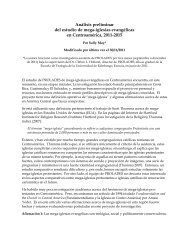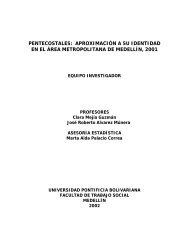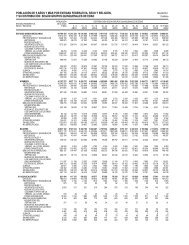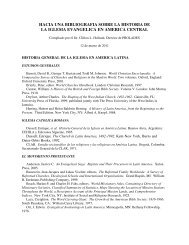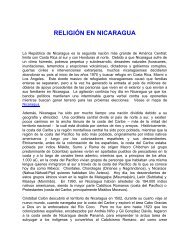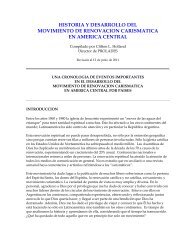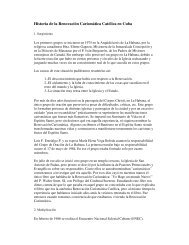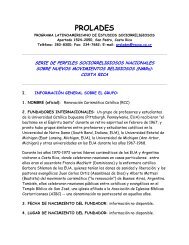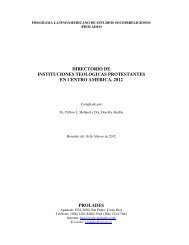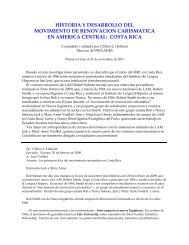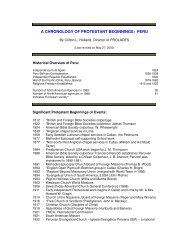Assemblies of God - Prolades.com
Assemblies of God - Prolades.com
Assemblies of God - Prolades.com
You also want an ePaper? Increase the reach of your titles
YUMPU automatically turns print PDFs into web optimized ePapers that Google loves.
41stVol. 5, No. 2, Summer 1985<strong>Assemblies</strong> <strong>of</strong> <strong>God</strong>HEFTIER.
The Origin and DevelopmentMinistry Among HispanicsThe late Victor de Leon, Jr. traces the origin <strong>of</strong> the Hispanicministry <strong>of</strong> the <strong>Assemblies</strong> <strong>of</strong> <strong>God</strong> to January 10, 1915.That was the day H.C. Ball, a former Methodist, was ordained atKingsville, Texas.’Not a single <strong>Assemblies</strong> <strong>of</strong> <strong>God</strong> congregation was set in orderamong Spanish-speaking Pentecostals at the time. In 1918 Ball andothers established the Latin American Conference <strong>of</strong> the TexasDistrict. In 1925 this wing <strong>of</strong> the Lone Star District became knownas the Latin American District.But the Pentecostal message was not to be fenced in amongHispanics in Texas. Soon other believers across the nation receivedthe Pentecostal experience, and the growth and development <strong>of</strong> themovement has been nothing less than phenomenal.The expansion brought about a need for a division in 1956. Thatis when the Spanish Eastern District was formed. The new geographicalarea included most <strong>of</strong> the territory east <strong>of</strong> the MississippiRiver plus Puerto Rico. Most <strong>of</strong> the territory west <strong>of</strong> the Mississippiwas retained by the Latin American District.Again in 1972 there came the need for reorganization. Fivedistricts were formed to serve the growing Hispanic ministry:Central Latin American, Gulf Latin American, Midwest LatinAmerican, Pacific Latin American, and Spanish Eastern. PuertoRico was a part <strong>of</strong> the Spanish Eastern District until 1975 when itbecame a separate district.The most recent division came in 1981 when the SoutheasternSpanish District was organized.It is easy to look back and see the tremendous progress <strong>of</strong> theHispanic ministry in the <strong>Assemblies</strong> <strong>of</strong> <strong>God</strong>. But many believe it isonly the beginning. As our Spanish-speaking population continuesto multiply, it is almost certain that the <strong>Assemblies</strong> <strong>of</strong> <strong>God</strong> Hispanicministry will increase as well. This will mean more converts, morechurches, and probably more districts.No two people can be any more pleased with the Hispanicphenomenon in the <strong>Assemblies</strong> <strong>of</strong> <strong>God</strong> than Anglo pioneers, HenryC. and Sunshine Ball.’A Bilingual ArticleENGLISH-SPANISHNuevamente en 1972 se vi6 la necesidad de una reorganizaci6n.Cinco distritos fueron formados para servir al ministerio:Distrito Latin0 Americano Central, Distrito Latin0Americano de1 Golfo, Distrito Latin0 Americano Este Central,Distrito Latin0 Americano de1 Pa&co y el Distrito Hispanode1 Este. Puerto Rico formaba parte de este dltimo hasta1975, abo en que lleg6 a ser un distrito aparte.La divisi6n m8s reciente ocurri6 en 1978 cuando el DistritoHispano Sur-este fue organizado.Es f&i1 dar una mirada hacia gtras y contemplar el tremendoprogreso de1 ministerio hispano en Las Asambleas deDios. Pero muchos creen que esto es solamente el principio.Mientras nuestro poblaci6n hispana contintie multiplic8ndose,es casi cierto que el ministerio hispano de las Asambleasde Dios crecera <strong>com</strong>a en el pasado.Esto resultara en m&s convertidos, m8s iglesias, y probablementem8s distritos.Nadie puedo gozarse m8s que 10s Hnos. Enrique C. y SunshineBall2 pioneros anglos, por el fen6meno hispano en lasAsambleas de Dios.‘Victor De Lebn - The Silent PentecostalsOtros pioneros entre 10s hispanos incluyen la esposa de1 Hno. Ball, Sunshine,Alicia Lute, Demetrio BazBn, padre, Jose Giron, Juan Lugo, FranciscoOlaza’bel, y M.M. Pinson.‘Estos pioneros respetados han cumplido 89 arias, han sido casados por67 afios, y residen en San Antonio, Texas. +?-LATIN AMERICAN DISTRICTS*DISTRICTCentralAlbuquerque, NMFrank Trevino, Supt.CHURCHESMEMBERSHIP106 6,559’ Victor De Leon, The Silent Pentecostals (published by author, 1979, p. 43).Other pioneers among Hispanics include Ball’s wife Sunshine, Alice Lute,Demetrio Bazan, Sr., Jose Giron, Juan Lugo, Francisco Olazabal, and M.M.Pinson.2 These revered pioneers are both 89, have been marriedfor 67yenrs, and maketheir home in San Antonio, Texas.E1 difunto Victor de Le6n, hijo, traza el origen de1 ministeriohispano de las Asambleas de Dios desde Enero 10,1915.Esa fub la fecha en que E. C. Ball, antes metodista, fu6ordenado en Kingsville, Texas.’No existia ni una congregaci6n organizada entre 10s pentecostalesde habla-espafiola en aquel tiempo. En 1918 elHno. Ball y otros establecieron la Conferencia Latin0Americana de1 Distrito de Texas. En 1925 esta zona de1 Distritode Texas fue llamada el Distrito Latin0 Americano.Pero el mensaje Pentecostal no se restringi6 a Texas. Dentrode poco, otros creyentes en toda la naci6n recibieron la experienciaPentecostal, y el crecimiento y desarollo de1movimiento no ha cesado de ser extraordinario.El crecimiento di6 lugar a la necesidad de una divisi6n en1956.FuB en ese afio que se form6 el Distrito Hispano de1 Este.Esta nueva Brea geogrfifica incluy6 el territorio al este de1Rio Mississippi y Puerto Rico. La mayor parte de1 territorioal oeste de1 Mississippi permaneci6 en el Distrito Latin0Americano.-GulfSan Antonio, TXJosue Sanchez, Supt.MidwestAurora, ILDaniel B. Enriquez, Supt.PacificLa Habra, CAJesse Miranda, Supt.Puerto RicoBayamon, PRRafael Miranda, Supt.Southeastern1 Plant city, FLGustavo A. Jimenez,supt.Spanish EasternBronx, NYAdolf0 Carrion, Supt.*Staristics are from 1984 reports280 27,45047 3,036258 24,I72176 17,72160 4,089198 22,3811,125 105,408A/G HERITAGE,Summer 1985 q
Above, one <strong>of</strong> the early graduating classes atLatin American Bible Institute. Standing, leftto right, Dario Solis, Nicanor Menchaca,Severiano Menchaca, Berthu Esturke, MelecioMenchaca, Arturo Ramirez, VenturaFlores, St-. . and Ramon Porras. Seated,Laura Kritz, Sunshine Ball, Henry C. Ball,Ruben Arevalo, _and Josue Cruz. Courtesy <strong>of</strong>H.C. Ball.Mack M. Pinson Alice E. Lute Henry C. BallEl Salvador Assembly, San Antonio, which H.C. Ball started in 1961. Courtesy <strong>of</strong> H.C. Ball.Books published by Alice E. Lute (1927),Henry C. Ball (1921) and Victor De Leon(1976).HIMNOSDEGLORIA- 1The silentkntecostals1 hll”,,hl ,I l//bl”,.,I ,a. h ,,,.,, * /I ,,/,” .,,,,,,,,/,,, “,” I* ,,,.,.,, ,,..,>,il” I”,“,Wh,,“~W~q A/G HERITAGE, Summer 1985
Pioneers <strong>of</strong> Pentecost:A Bilingual Article ENGLISH-SPANISHAlice E. Lute and Henry C. BallBy Gary B. McGee, Ph.D.The growth <strong>of</strong> the Pentecostal faith among Hispanics in NorthAmerica is usually associated with the pioneer ministries <strong>of</strong>Henry C. Ball, Alice E. Lute, Juan L. Lugo, and FranciscoOlazabal. The early efforts <strong>of</strong> these individuals paralleled theorganization <strong>of</strong> the <strong>Assemblies</strong> <strong>of</strong> <strong>God</strong> in 1914. Their ministriesconstituted one <strong>of</strong> the earliest endeavors by Council members toevangelize an ethnic minority at their own doorstep.Two <strong>of</strong> them, Henry C. Ball and Alice E. Lute, were lifelongfriends and colleagues who fulfilled particularly significant roles.“They shared a <strong>com</strong>mon goal: the evangelization <strong>of</strong>Hispanics in the Western Hemisphere through theestablishment <strong>of</strong> strong indigenous churches.”In many ways, they were opposites. Lute had been well-educatedin England, served as a missionary to India, spoke five languages(English, French, Hindi, Urdu, Spanish), remained single andfocused her later ministry in California. Ball never attended a Bibleschool, struggled to learn Spanish, married Sunshine Marshall in1918 and devoted a large share <strong>of</strong> his ministry in Texas. Here thedifferences end.Even though they worked variously as pastors, evangelists,writers, educators and administrators, they shared a <strong>com</strong>mon goal:the evangelization <strong>of</strong> Hispanics in the Western Hemispherethrough the establishment <strong>of</strong> strong indigenous churches. Althoughthe year 1985 marks the 70th anniversary <strong>of</strong> their ordinations by the<strong>Assemblies</strong> <strong>of</strong> <strong>God</strong>, their successful efforts at evangelism andperspectives on building a strong indigenous work still deservecareful consideration. ’E1 crecimiento de la fe Pentecostal entre 10s hispanos dela America de1 Norte suele ser asociado con 10s ministeriospioneros de Enrique C. Ball, Alicia E. Lute, Juan L.Lugo, y Francisco Olazhbal. Los esfuerzos tempranos de estosindividuos fueron paralelos a la organizaci6n de lasAsambleas de Dios en 1914. Sus ministerios constituyeronuno de 10s esfuerzos m8s tempranos de 10s miembros de1 Conciliapor evangelizar una minoria Btnica dentro de nuestrasfronteras.DOS de ellos, Enrique C. Ball y Alicia E. Lute, eran amigosconstantes y colegas quienes cumplieron una parte muy significante.En muchas maneras eran opuestos. La Hna. Lutehabi& gozado de una buena educaci6n en Inglaterra, habiaservido de misionera en la India, hablaba cinco idiomas (ingl6s,franc&, indostAnico, urdu, y espadol), habia permanecidosoltera y concentr6 su ministerio posterior enCalifornia. El Hno. Ball nunca asisti6 a un instituto biblico,luch6 para aprender el idioma espafiol, se cas6 con SunshineMarshall en 1918 y dedic6 la mayor parte de su ministerioa la obra en Texas. Aqui terminan las diferencias.Aunque trabajaban individualmente <strong>com</strong>a pastores,evangelistas, autores, pr<strong>of</strong>esores y administradores, <strong>com</strong>partieronun mismo prop6sito: la evangelizaci6n de 10s hispanosen el hemisferio occidental por medio de1 establecimiento deiglesias fuertes e indigenas. Aunque el ado 1985 marca elseptuag&imo aniversario de sus ordenaciones por lasAsambleas de Dios, sus esfuerzos productivos en el campo dela evangelizaci6n y sus prop6sitos de edificar una obra fuertee indigena todavia merecen la consideraci6n cuidadosa.’Alicia E. Lute (1873-1955)WAlice E. Lute (1873-1955)ith a French Protestant (Huguenot) ancestry, Alice EvelineLute was born in Cheltenham, England, in 1873. Her father,the Reverend J.J. Lute, served as vicar <strong>of</strong> St. Nicholas Church(Anglican) in Gloucester, England. She was converted to Christ at10 years <strong>of</strong> age and felt a strong inclination to the Christianministry. Following high school she was educated at the CheltenhamLadies’ College and later studied nursing and theology.*Her intense desire for ministry led her to journey in 1896 to Indiaas a missionary under appointment with the Church MissionarySociety (CMS). She settled in Azimgarh, United Provinces, andworked in a school there and among women isolated in harems or“zenanas.“’With the emergence <strong>of</strong> the Pentecostal Movement early in thiscentury, news <strong>of</strong> the baptism in the Holy Spirit finally reached herin India. Hearing <strong>of</strong> two women who had received this experience,;he visited them to find out more about this baptism. ConvincedDr. Gary B. McGee is an associate pr<strong>of</strong>essor <strong>of</strong>theology and church history at the <strong>Assemblies</strong> <strong>of</strong><strong>God</strong> Theological Seminary, Springfield, Missouri.He is the author <strong>of</strong> This Gospel Shall Be Preached(to bepublished by the Gospel Publishing House in1986), the story <strong>of</strong> the <strong>Assemblies</strong> <strong>of</strong> <strong>God</strong> Division<strong>of</strong> Foreign Missions (to 1959). He is co-editor <strong>of</strong>the Dictionary <strong>of</strong> American Pentecostal and CharismaticMovements (which will be published bythe Zondervan Publishing House).e linaje franc& protestante (Hugonote) Alicia EvelinaD Lute naci6 en Cheltenham, Inglaterra, en 1873. Supadre, el reverend0 J.J. Lute, servia de vicario en la iglesiade San Nicoks (anglicana) en Gloucester, Inglaterra. Ella seconvirti6 a Cristo a la edad de 10 afios y sinti6 una fuerteinclinaci6n hacia el ministerio cristiano. Despuks de terminarla instrucci6n media, se educ6 en el Colegio de Cheltenhampara sefioritas, y mls tarde estudi6 enfermeria y teologia.’Su vivo deseo de trabajar en el ministerio cristiano la llev6a la India en 1896 <strong>com</strong>a misionera nombrada por la Iglesiade Sociedad Misionera (CMS). Allf estableci6 su residenciaen Azimgarh, Provincias Unidas, y trabaj6 en una escuelaalli; tambi6n entre las mujeres recluidas en 10s harenes“zenanas.“3Con la aparici6n de1 primer movimiento Pentecostal en estesiglo, las noticias de1 bautismo en el Espiritu Santo llegarona la India. Al saber de dos mujeres quienes habian recibidoesta experiencia, ella las visit6 para averiguar m&s acercade este bautismo. Convencida de que era de Dios, ella or6hasta recibirlo (ca. 19101.’Dentro de corto tiempo, se enfermb <strong>com</strong>a resultado de beberagua contaminada. Despubs de un period0 de convalecenciavolvi6 a su hogar en 1912. En el afio siguiente su iglesia laenvi6 a la Misi6n Zenana Biblica, (ahora conocida <strong>com</strong>a laConfraternidad Biblica y Misionera de Servicio M6dico.1 Suasignaci6n al trabajo de secretaria le oblig6 a viajar a Vancouver,Columbia BritBnica, Canadk Allf en 1914 renunci6a su iglesia por causa de una diferencia de opiniones medicas. 5Mientras se&a en CanadB, sintid el llamamiento de Diospara ir a Mbjico <strong>com</strong>a misionera. La revoluci6n mejicana, sinembargo, cambi6 sus planes y con el tiempo ella se cambi6A/G HERITAGE,Summer 1985 q
that this was from <strong>God</strong>, she prayed until she received it (ca. 1910).’Before long, illness struck as a result <strong>of</strong> drinking contaminatedwater. After a period <strong>of</strong> convalescence she returned home in 19 12.In the following year the CMS loaned her to the Zenana Bible and‘Alice Lute believed that apostolic methods would befollowed by the power and demonstration <strong>of</strong> the Holy Spirit.”Medical Mission (now known as the Bible and Medical MissionaryFellowship). Secretarial work with this agency required her tomove to Vancouver, British Columbia, Canada. In 1914 sheresigned from the CMS on medical grounds.’While serving in Canada she felt called <strong>of</strong> <strong>God</strong> to go to Mexico asa missionary. The Mexican Revolution, however, altered her plansand eventually she moved to Texas. It was there that she becameacquainted with Henry C. Ball, Sunshine Marshall, Mack M.Pinson, and Lloyd Baker. This association with other Pentecostalbelievers led to her ordination in 1915 by Pinson into the newlyorganized General Council <strong>of</strong> the <strong>Assemblies</strong> <strong>of</strong> <strong>God</strong>.Lute had journeyed from England, to India, Canada, and finallyto the United States to begin the most significant part <strong>of</strong> herministry.Two years later Lute and Sunshine Marshall traveled to Monterrey,Mexico, for missionary work. Because <strong>of</strong> the Revolution,however, they were forced to return to the United States. Followingthis disappointment, she moved to Los Angeles, to begin evangelisticwork among the Hispanics living in that city.Realizing that the best way to evangelize this population wasthrough training pastors and evangelists, she founded the BereanBible Institute in 1926 and served at that school until her death in1955. The school is currently known as the Latin American BibleCollege and is located in La Puente, California.he significance <strong>of</strong> Alice E. Lute in the history <strong>of</strong> the Assem-T blies <strong>of</strong> <strong>God</strong> and Hispanic evangelism is threefold. First, herefforts at Bible institute training prepared the way for many youngpeople to minister effectively to their own people. The school in LaPuente and its graduates are a monument to her vision for trainingan indigenous clergy.Her second area <strong>of</strong> influence resulted from her many publications.Victor De Leon, late assistant superintendent <strong>of</strong> thePacific Latin American District and historian <strong>of</strong> Hispanic Pentecostalism,noted that in the first 20 years <strong>of</strong> the Bible institutewhere she served, most <strong>of</strong> the curricular materials (books andnotes) were prepared by her.h The Gospel Publishing House publishedthree <strong>of</strong> her books: The Messenger and His Message ( 1925),The Little Flock in the Last Days ( 1927), and Pictures <strong>of</strong> Pentecost(nd.). Other Latin American institutes also used her materials.Lute’s literary output was enormous. She regularly contributedto the Apostolic Light published by Henry C. Ball. Writing inEnglish for the Gospel Publishing House, she wrote lesson <strong>com</strong>mentsfor intermediate and senior Sunday school teachers’ quarterliesfor many years.ssemblies <strong>of</strong> <strong>God</strong> church members, like other Pentecostals,A believed that the Spirit had been outpoured in “the last days”as an enduement <strong>of</strong> power for the evangelization <strong>of</strong> the world.Identification with the beliefs and practices <strong>of</strong> the Early Churchcharacterized their preaching and perspectives on ministry. Asearly as the second meeting <strong>of</strong> the General Council in November1914, the new organization <strong>com</strong>mitted itself to the evangelization<strong>of</strong> the world according to New Testament principles.’ However,these did not receive careful definition until the General Councilmet at St. Louis in 1921. The articulation <strong>of</strong> a missionary strategya Texas. Fue alli donde conocio a Enrique C. Ball, SunshineMarshall, Mack M. Pinson, y Lloyd Baker. Esta asociacioncon otros creyentes pentecostales result6 en su ordenacionen 1915 por el Hno. Pinson en el Concilio General recienorganizado de las Asambleas de Dios.La Hermana Lute viajo a Inglaterra, a la India, al Canada,y finalmente a 10s Estados Unidos para principiar la partem&s importante de su ministerio.DOS ados despues, las Hnas. Lute y Sunshine Marshallviajaron a Monterrey, Mejico, para hater la obra misionera.Sin embargo, por causa de la revolution se vieron obligadasa volver a 10s Estados Unidos. Despues de este contratiempo,la Hna. Lute se traslado a Los Angeles, para principiar laobra evangelistica entre 10s hispanos de aquella ciudad.Comprendiendo que la mejor manera para evangelizar estepueblo era por el entrenamiento de pastores y evangelistas,ella fund6 el Instituto Biblico Berea en 1926 y sirvio en esaescuela hasta su muerte en 1955. La escuela actualmenteconocida <strong>com</strong>a el Colegio Biblico Latin0 Americano se encuentraen La Puente, California. 1La Importancia de Alicia E. Lute en la historia de lasAsambleas de Dios y el evangelism0 hispano es triple.Primero, sus esfuerzos por el entrenamiento en el institutobiblico prepare el camino para que muchos jovenes pudieranministrar efectivamente entre su propio pueblo. La escuelaen La Puente y sus graduados son un monument0 a su visionde entrenar un clero hispano.La segunda area de su influencia result6 de sus numerosaspublicaciones. Victor De Leon, difunto superintendente asistentede1 Distrito Latin0 Americano de1 Pacific0 e historiadorde1 pentecostalismo hispano, not6 que en 10s primeros veinteanos de1 instituto biblico donde ella sirvio, casi todos 10smateriales y estudios (libros y notas) fueron preparados porella. The Gospel Publishing House public6 tres de sus libros:“The Messenger and His Message” (1925), “The Little Flockin the Last Days” (1927), y “Pictures <strong>of</strong> Pentecost” (fechadesconocida). Otros institutos latinoamericanos usaron susmateriales.La production literaria de la Hna. Lute era enorme. Regularmentecontribuia a “La Luz Apostolica” publicada por EnriqueC. Ball. Escribia tambien en ingles para The GospelPublishing House, principalmente <strong>com</strong>entarios sobre las leccionesde escuela dominical en 10s expositores para 10s maestrosde intermedios y adultos durante muchos anos.Los miembros de las iglesias Asambleas de Dios, <strong>com</strong>a otrospentecostales, creian que el Espiritu habia sido derramadoen “10s ultimos dias” <strong>com</strong>a revistimiento de poder para laevangelization de1 mundo. La indentificacion con las doctrinasy practicas de la Iglesia primitiva caracterizaba supredicaci6n y perspectivas de ministerio. Tan temprano <strong>com</strong>ala segunda reuni6n de1 Concilio General en Nov 1914, lanueva organization se <strong>com</strong>prometio a la evangelization de1mundo conforme a 10s principios de1 Nuevo Testamento. Sinembargo, estos principios no fueron muy bien estudiadoshasta que se reuniera el Concilio General en St. Louis en1921. La articulation de la estrategia misionera constituyesu tercera contribuci6n y explica la direction de su ministerio.Temprano en el 1921, antes de que se reuniera el ConcilioGeneral, la Hna. Lute contribuyo con una serie de tres articulospara The Pentecostal Evangel entitulada “LosMetodos Misioneros de Pablo.” Esto representaba la primeraexposition de 10s principios de una iglesia indigena paraaparecer en aquella publication aunque anteriormente sehabian publicado breves referencias a su obra. Asi que 32afios antes de la publication de The Indigenious Church, escritapor Melvin L. Hodges, la Hna. Lute habia, aclarado 10smismos principios tratando de1 establecimiento de iglesiaspentecostales que fuesen auto-suficientes en su sostenimiento,gobierno, y propagation. Estos principios guiaronel programa misionero de las Asambleas de Dios durante 10sContinued on page I2q A/G HERITAGE, Summer 1985
Paratroopers <strong>of</strong> I I th Airborne jump at Los Banos. Inset, Rena Baldwin and Blanche Appleby.The spring issue <strong>of</strong> Heritage carried the firstpart <strong>of</strong> the Philippines liberation story, “ 1945Phillippine Liberation Creates EmotionalScenes. ’’It was the story <strong>of</strong> the U.S. Army 1st Cavalry’sliberation <strong>of</strong> 3,700 civilians and nurses atSanto Tomas University in Manila, The nextday the 37th Division rescued another 1,300civilians and POWs at Old Bilibid Prison,about 10 blocks from Santo Tomas.Being held at Bilibid were <strong>Assemblies</strong> <strong>of</strong><strong>God</strong> missionaries, Leland and Helen Johnson,and their children Constance, Sammy, andMargaret-Joy; Robert and Mildred Tangen,and their son Robert; Elizbeth Galley (nowWilson); Gladys Knowles (now Finkenbinder);and Doris Carlson.This final part <strong>of</strong> the Philippine rescue tookplace at the Los Banos internment camp, about40 miles south <strong>of</strong> Manila, February 23, 1945.Two other <strong>Assemblies</strong> <strong>of</strong> <strong>God</strong> missionaries,Blanch Appleby and Rena Baldwin (later Lindsay)were among the 2,145 civilians interned atLos Banos.On June 1 I, while this story was beingprepared, Rena Baldwin Lindsay, 93, died atMaranatha Village, Springfield, Missouri.Blanche Appleby died in 1968 at the age <strong>of</strong> 80.The author is indebted to several organizations,individuals, and written accounts forinformation and photographs used in the stories.These include the 1st Cavalry DivisionAssn., the 11 th Airborne Division Assn., the37th Division, individual veterans and internees,the <strong>Assemblies</strong> <strong>of</strong> <strong>God</strong> Division <strong>of</strong> ForeignMissions, the Library <strong>of</strong> Congress, and theNational Archives.-The Dramatic 1945 LiberationLos Banos, Philippines2,147 civilians were starving,and it was rumoredthat they would be killed.Then 130 “angelic” paratroopersfloated out <strong>of</strong> thesky. 17 By Wayne WarnerThe Los Banos concentration camp onthe 60-acre campus <strong>of</strong> the University<strong>of</strong> the Philippines College <strong>of</strong> Agriculturewas just beginning to stir that morning,February 23, 1945. Little could the 2,147civilian internees and the nearly 250Japanese guards imagine what would happenwithin the next few minutes.They were to be involved in one <strong>of</strong> themost dramatic military raids in history -one that would be overshadowed that dayonly by a story <strong>com</strong>ing from Iwo Jima.There the U.S. Marines planted theAmerican flag on Mt. Suribachi.For the emaciated internees the situationwas be<strong>com</strong>ing desperate. They had beentold the day before that there would be n<strong>of</strong>urther food rations issued. Rumors werecirculating that the enemy planned to exe--cute the entire camp on the day <strong>of</strong> the raicQuestions were racing through thminds <strong>of</strong> internees that morning while 4miles away the fierce battle for Manila wafinally winding down.Questions such as:What is Lt. Kinishi planning?’Will we starve to death?Will we be shot?Where is General MacArthur?When will we be set free?The answers would <strong>com</strong>e withiiminutes from a force <strong>com</strong>posed <strong>of</strong> the 11 tlAirborne Division, Filipino guerrillas, antother military units.T wo<strong>of</strong> the internees who were slowl;dying <strong>of</strong> starvation were veterai<strong>Assemblies</strong> <strong>of</strong> <strong>God</strong> missionaries, BlancheAppleby and Rena Baldwin. Originall:they had served in China, but when theJapanese invaded China they were movecto Baguio, Luzon. There they taught in thlnewly opened Bethel Bible Institute.When the Japanese forces occupied Luzon in December 1941, the missionariesother civilians, and American militar!personnel were imprisoned. An internment camp was set up at Camp John Ha:A/G HERITAGE, Summer 1985 q
near Baguio, where the missionaries remainedfor 5 weeks. Then they were releasedand told they could return to theirhomes.In the fall the missionaries were reinternedat Camp John Hay. But Rena andBlanche were overlooked. For nearly 2years they were permitted to live in theirsmall tin house and conduct services atBethel Church. Among those who attendedservices were Filipino soldiers who hadbeen captured on Bataan and imprisonedfor many months.Writing about that 2-year period later,Rena noted that many were converted andhealed, and about a dozen received thePentecostal experience.lBut then the dreaded day arrived. Soldiersknocked on their door one day in July1944 with an internment order. This time,however, they were sent south to LosBanos, located on the southern end <strong>of</strong>Laguna de Bay.’At Los Banes Rena and Blanche found acamp <strong>of</strong> more than 2,000 internees. Most<strong>of</strong> them were American civilians who hadbeen working in the Philippines when thewar came.Civilian internees imprisoned at SantoTomas University in Manila dubbed theLos Banos camp “the country club,” be-cause gardens were permitted at LosBanos, and the internees received threemeals a day.But then in September 1944 the situationchanged. The three meals a day werecut to two and gardens were restricted.The diet became very meager. It includeda small portion <strong>of</strong> rice and corngruel - which was wormy and musty -in the morning, and then at 4:30 anothersmall portion <strong>of</strong> rice gruel and sweet potatoleaves and “a wee bit <strong>of</strong> sweet potato.”Blanche Appleby’s weight haddropped from 115 pounds to 79.4The internees foraged for leaves, snails,grass, or anything else that would helpsupplement their starvation diet. By theend <strong>of</strong> their long night <strong>of</strong> captivity theywere given only hot water.’This apparent deliberate plan <strong>of</strong> malnutritionwas suspended for one week inJanuary 1945. Blanche later recalled thatshe was in a gully picking weeds, tearsstreaming down her face, but then somethinghappened. “Suddenly the Spirit <strong>of</strong><strong>God</strong> came upon me, and I began to sing, ‘Iknow the Lord will make a way for me.’ “6The next day the enemy guards desertedLos Banos .The Japanese had no sooner left theinternment camp when hungry interneesrushed to their captor’s quarters and raidedthe food storage area and looted personalitems that belonged to the guards.Wiser heads among the internees prevailed,and the food was distributed so thatthey would have some left in case theguards returned.Patty Cr<strong>of</strong>t Kelly, who was a teenageinternee, said her mother had concealed anAmerican flag during their imprisonment.She brought it out after the guards left, andmen in the camp erected a flag pole. Soonthe American flag was raised over thecamp. And then the British interneesbrought out their own flag, and it too wentup a second pole.’But the week <strong>of</strong> freedom came to an endwhen the Japanese guards moved back intothe camp. Fortunately the internees wereable to remove the flags before the enemyspotted them.onditions after the week <strong>of</strong> freedomC grew steadily worse. People who hadhad a glimmer <strong>of</strong> hope were now despondent,thinking perhaps MacArthur’sforces would never free them in time.One writer described Los Banos as aplace “peopled by a gaunt, haggard crew<strong>of</strong> spectators who dragged themselvesContinued on page 10q A/G HERITAGE, Summer 1985
John M. Ringler, <strong>com</strong>mander <strong>of</strong> the paratrooperswho jumped at Los Banos. He is nowa retired colonel and lives in Fayetteville,North Carolina. Courtesy <strong>of</strong> John M. Ringler.The Raid atLos BanesFebruary 23,194sArtwork <strong>of</strong> Los Banos camp used on book That We MightLive, by Grace C. Nash. Courtesy <strong>of</strong> author.A food drop to internees at New Bilibid Prison after the rescue from Los Banos.Courtesy <strong>of</strong> National Archives.Two 11 th Airborne <strong>of</strong>ficers receive decorations in the Philippinesafter the Los Banos raid. On the left is General Joseph Swing,division <strong>com</strong>mander, and Major Henry Burgess. Swing is deceased;Burgess is an attorney in Wyoming. Courtesy <strong>of</strong> HenryBurgess.A/G HERITAGE, Summer 1985 q
Los Banosh0mpage 8around attending to the business <strong>of</strong> livingthrough sheer courageous will power.“’Time was running out. Nobody knew itany better than the internee police chief, aSeventh-Day Adventist educator, Dr.Lawrence M. Stump. Stump, who is now86 and living in Sonoma, California, andother internee leaders met with the Japanese<strong>of</strong>ficers to request more food.They were told in so many words that itwas tough all over: Japan, America, andin the foxholes. Lt. Kinishi, the cruel<strong>of</strong>ficer in charge <strong>of</strong> food rations, told theinternee council and the other Japanese<strong>of</strong>ficers, “We have all the food we willneed. ’“’Stump recalled a touching story <strong>of</strong> aPresbyterian missionary who lost the willto live. “I helped Brother Blair to thehospital when he got sick, and that iswhere his spirit broke.” He had waited 3long years but then lost all hope for arescue. “We tried to encourage him,”Stump added, “but he gave up anddied.“‘”On the same day that Blair died,Blanche Appleby became so weak and -like Blair and so many others in the camp- thought she could not go on. She layon her bed on the verge <strong>of</strong> giving up, Thatis when Julia Hodge, a Presbyterian missionary,came by and opened the Bible tothe Psalms.“As she read,” Blanche wrote later,“the words <strong>of</strong> the Scripture were just lifeto me, and I became wonderfully revivedin spirit and soul and body.“”The next day was Friday, February 23,194.5. The day <strong>of</strong> liberation for LosBanos.But before the American forces couldarrive the internee leaders knew somethinghad to be done. Someone had to getword to General MacArthur. It was anextremely risky mission, but two youngmen - Ben Edwards and Peter Miles -volunteered to escape and go for help.Their intelligence reports proved invaluableto the raiding forces in the nextfew days.eneral Joseph Swing’s 1 lth AirborneG Division had earned a well-deservedreputation as a disciplined, courageousoutfit in battles before it landed on Luzon.The division was known un<strong>of</strong>ficially as“Joe Swing and his 10,000 bandits.”After the raid at Los Banos they wouldbe known as “The Angels.“” The reasonis that internees who looked into the skyand saw the paratroopers floating to theirrescue thought at first they were indeedangels from heaven.Tokyo Rose, the radio propagandistduring World War II, supposedly reportedthat the I lth Airborne was destroyed.But the division’s death was-q A/G HERITAGE, Summer 1985exaggerated, for it was the first Americanunit to set foot on Japan and was chosenas a guard <strong>of</strong> honor for GeneralMacArthur.On Sunday, February 18, 1945, severalkey <strong>of</strong>ficers <strong>of</strong> the 1 lth Airborne werepulled out <strong>of</strong> the battle for Manila andordered to report for a secret meeting.This included Colonel Robert Soule,Major Henry Burgess, Lt. John Ringler,and Lt. George Skau. Here for the firsttime <strong>of</strong>ficers <strong>of</strong> the 11 th Airborne heardabout Los Banos and the raid.General Swing told his <strong>of</strong>ficers that theassignment would be most difficult andwould require absolute secrecy and per-LOS BAR05 RAIDfeet timing. Otherwise the units participatingas well as the internees could bewiped out.Colonel Some would be overall <strong>com</strong>mander;Major Burgess would be incharge <strong>of</strong> the ground forces; Lt. Ringlerwould <strong>com</strong>mand the approximate 130paratroopers who would make the jump;Lt. Skau would be in charge <strong>of</strong> a reconnaissanceplatoon which would arrive atLos Banos the night before the raid.The <strong>of</strong>ficers had a lot to think about asthey poured over maps and intelligenceinformation. The biggest concern wasthat the raid would be made several milesbehind enemy lines and that within 2hours marching time there were 10,000Japanese troops.The plan for evacuating the interneeshad two options.Colonel Soule’s 188th Regiment wouldopen the highway from Manila along thewest side <strong>of</strong> Laguna de Bay. They wouldtake trucks for the evacuation <strong>of</strong> theinternees. In the event Soule’s force couldnot get through to Los Banos, the assignmentto evacuate the internees would fallon the shoulders <strong>of</strong> the 26-year-old major,Henry Burgess.”Burgess would <strong>com</strong>mand 59 amphibiousvehicles, called amtracs or alligators,which would cross Laguna de Bay duringthe early morning hours <strong>of</strong> February 23.The amtracs and their drivers would beborrowed from the 672nd AmphibianTractor Battalion. They were slow andwould be a last resort for the evacuation.A sober John Ringler left the meetingthat Sunday “knowing I had 80 men thatcould go down the drain.“14An encouraging note in the plan wasthat General Swing promised air cover inthe raid. Another important factor wasthat the 188th Regiment’s line <strong>of</strong> travelwould cause a diversionary attack, drawingthe enemy away from Los Banos.George Skau, who would later lose hislife in a plane accident on Okinawa,would be responsible for marking thebeach with colored smoke for the amtraclanding, mark the drop area for the paratroopers,organize Filipino guerrillas, andattack the guards when Ringler’s men begantheir jump on the morning <strong>of</strong> February23.Ringler’s paratroopers, about 130 inall, were to be flown to Los Banos fromManila in nine C-47s. Their plan was tojump just before 7 o’clock when theenemy guards would be at their calisthenicsand unarmed.The plans were laid. Time would tellwhether they could be executed.riday, February 23 began as mostF days in Los Banos. Hungry and sickinternees began to stir for another wearyday. This day would be different, however,and the first indication came whenearly risers noticed nine planesapproaching the camp.One <strong>of</strong> the many Catholic priests internedat Los Banos, George J. Willmann,saw the planes but paid little attentionbecause American planes frequently\” ‘Girls, look! An American soldier!’Oh, how good he looked to us.” -Rena Baldwinflew over the area. Then he saw the paratroopers,but he thought the objects fallingfrom the planes were leaflets.Then he learned a few moments laterthat this was no leaflet drop; it was the1 lth Airborne floating out <strong>of</strong> the sky andlanding just outside the Los Banos internmentcamp.”Sister Patricia Marie Cailan also sawthe planes approaching the camp, and shewill never forget what happened next.
“In the face <strong>of</strong> the rising sun, parachutesstarted tumbling out <strong>of</strong> the planes, and wewere all screaming, ‘Parachutes! Parachutes!’“I’Blanche Appleby and Rena Baldwinwere in their bamboo barracks when theyheard shooting and excitement outside.Rena looked outside when the firingeased somewhat and cried, “ ‘Girls,look! An American soldier!’ Oh, howgood he looked to us.“”The raid could not have been executedmore perfectly. Fifteen minutes after theaction began, the roaring amtracs crawledthrough the gate. By this time the paratroopersand the Filipino guerrillas werein charge <strong>of</strong> the internment camp. Casualtiesfor the allied forces were light: two <strong>of</strong>the guerrillas had been killed and a fewhad been wounded. But the entire enemyforce had either been eliminated or driven<strong>of</strong>f.Not even the seasoned military peoplecould believe that the raid had been SOsuccessful. For some GIs it was their firstexperience being closely associated withthe heroic guerrillas - an undermannedforce which contributed greatly to thesuccess <strong>of</strong> the raid.“I am deeply grateful [for successfulraid]. <strong>God</strong> was certainly with ustoday.” - General Douglas MacArthurThe internees began to realize that theywere not dreaming, that their longawaitedliberators had <strong>com</strong>e.Emotions could not have been runningany higher for the McCarthy family.Frances McCarthy, a United Press warcorrespondent, ac<strong>com</strong>panied the amphibiousforce for something more than astory. His brother and sister were internees,and it was the end <strong>of</strong> a long andtrying separation?Another internee, William Henry Donald,an Australian and a close friend andadviser to General and Madam ChiangKai-Shek <strong>of</strong> China, was especially happyto be free. He had been interned in Manila5 days after the war began. For 3 yearsthe Japanese military had looked for him,not realizing that he was already in theirhands. War correspondents for the ChicagoDaily Times said Donald “wasbreathing easy for the first time in years<strong>of</strong> hide and seek.“‘”Now the only problem facing the militaryforce was to get the internees out <strong>of</strong>the area before enemy infantry and tankssurrounded them. The first plan was toevacuate by trucks furnished by the 188thInfantry Regiment, but that unit was engagedin heavy fighting and had notbroken through to Los Banos.Major Burgess waited as long as hedared and then ordered the loading <strong>of</strong> theamtracs. Out <strong>of</strong> necessity, plan twowould be used.The internees were not used to the careand concern demonstrated by their liberators.Father Willman said the soldiers“tumbled over each other to carry thestretcher cases. “>”Blanche Appleby was one <strong>of</strong> the last toget in one <strong>of</strong> the 59 amtracs. She had tocrouch beneath a machine gun. Whennearby enemy forces began to fire on theretreating amtracs, the gunner on theiramtrac opened up with his machine gun.Suddenly the hot spent shells began to fallon the crouching Blanche, burning herback. Finally someone put a coat over herfor protection.Paul Kucik, a soldier in one <strong>of</strong> the amtracs,said he gave one <strong>of</strong> the internees aLETTERS FROM OUR READERSPhilippines LiberationIn behalf <strong>of</strong> the First Cavalry DivisionAssociation, I would like to thank you forthe copy <strong>of</strong> your spring issue.It was very interesting to read Mr. Warner’saccount <strong>of</strong> the liberation <strong>of</strong> interneesin which our Division took part.I am passing the publication on to some<strong>of</strong> our members who participated in the“Flying Column” which liberated SantoTomas.Robert F. Litle, Jr.Col. USA (Ret)Executive Director1 st Cavalry Division Assn.Copperas Cove, TexasMore on the Nile MotherGreetings from Egypt!We were very delighted to find thewrite-up on the “Nile Mother” in thewinter 84-85 Heritage. Would it be possiblefor you to mail us 10 more copies <strong>of</strong>this issue? This being the 75th celebrationyear <strong>of</strong> the Lillian Trasher Orphanage,these publications have an extra meaningto us.Thank you for all your help and alsoyour interest in the heritage <strong>of</strong> our LillianTrasher Orphanage.Dwight R. DobsonMissionaryLillian Trasher OrphanageEgyptWe are happy to have a small part in the75th anniversary <strong>of</strong> the orphanage. Tencopies <strong>of</strong> the winter Heritage are on theway.Appreciates Their Pentecostal HeritageWe have been members <strong>of</strong> FirstAssembly in Memphis for some 30 years.My wife’s grandfather, Richard ErvinTaylor, was one <strong>of</strong> the original A/G ministersduring the early Pentecostal revival inAlabama and Florida. He pastored ElBethel (Alabama), Graceville (Florida),and numerous other churches.We appreciate the ministry <strong>of</strong> the Archivesand look forward to future issues <strong>of</strong>Continued on page 16Heritage. We thank <strong>God</strong> for our mostrichly blessed heritage. Your articles willkeep us mindful <strong>of</strong> past years.James and Lois DazeyCordora, TennesseeElva K. Stump 100 Years OldI sure enjoy reading Heritage. I havememories <strong>of</strong> more than 55 years in Pentecost.I will be 100 years old May 30,1985. I live with my son John and hisfamily. They are pastors <strong>of</strong> Faith ChapelAssembly <strong>of</strong> <strong>God</strong>.My life has been and is wonderful servingthe Lord. I give Him all the glory.Elva K. StumpBoca Raton, FloridaThe editor enjoyed visiting by telephonewith Sister Stump on her birthday. She is avivacious believer who encourages otherswherever she goes,ARCHIVESACTIVITIESRecent AcquisitionsBook Donors: T.C. Cunningham, Raymond T.Brock, Sear1 W. Stover, Alfred Worth, MichaelMorris. Talmadge F. McNabb, Lee Shultz, ThomasF. Harrison, Dorothy Bostrom.Music, books, tracts, missionary memorabilia,and other materials owned by the late Rena BaldwinLindsay, donated by Mrs. Roger Hunt.Tracts, books, and other items donated by Home<strong>of</strong> Peace, Oakland, California, Fredolf B. Sondeno,Director.Interviews: Faith Montgomery Berry; Frank J;Hitchin; H.C. and Sunshine Ball; Ruth McKenney.Sermon tapes (IO) donated by Lome F. Fox.Photo album on Upper Midwest, on loan from KayTrygg.Photographs, Fred Griesinger.Periodicals WantedAny Pentecostal periodical, local or national, willbe useful in the Archives. The AposrolicFrrith, editedby E.N. Bell is one <strong>of</strong> these needed. It was publishedprior to 1912.Another early Pentecostal paper needed is TheNew Acrs, published by Levi Lupton, AllianceChurch, Alliance, Ohio, from about 1906 to about1912. It eventually nwged with The Lurrer RainEvapgel.A/G HERITAGE, Summer 1985a
hce and Ball/from p. 6for the <strong>Assemblies</strong> <strong>of</strong> <strong>God</strong> constitutes her third contribution andexplains the direction for her ministry.Early in 1921, before the General Council met, Lute contributeda series <strong>of</strong> three articles to The Pentecostal Evangel titled “Paul’sMissionary Methods.“* This represented the first exposition <strong>of</strong>indigenous church principles to appear in that publication althoughbrief references to them had appeared before. Thus 32 years beforethe publication <strong>of</strong> The Indigenous Church, authored by Melvin L.Hodges, Lute articulated the same principles aimed at the establishment<strong>of</strong> self-supporting, self-governing, and self-propagatingPentecostal churches. These principles have guided the <strong>Assemblies</strong><strong>of</strong> <strong>God</strong> missions program over the years and also explain theremarkable success <strong>of</strong> Hispanic evangelism in the United States.Like Hodges, Lute was influenced by the writings <strong>of</strong> RolandAllen, an Anglican missionary to North China. His first book,Missionary Methods: St. Paul’s or Ours?, was published in I9 12.She reflected that her work in India with the CMS had followed theold paternalistic approach to missionary evangelism which allowedthe sending agency to retain control over the young churches andsubsequently stifled their initiative. Lute and her colleagues initiallyfelt that Allen’s suggestions were visionary and impractical.But further study led her to realize “the diametrical distinctionbetween our methods <strong>of</strong> working and those <strong>of</strong> the New Testament.“9This new approach changed her ministry.As a Pentecostal however, she went beyond Allen in her view <strong>of</strong>New Testament evangelism. Lute believed that apostolic methodswould be followed by the power and demonstration <strong>of</strong> the HolySpirit. In her second article on “Paul’s Missionary Methods,” sheasked: “When we go forth to preach the Full Gospel, are we goingto expect an experience like that <strong>of</strong> the denominational missionaries,or shall we look for the signs to follow?“‘”A clear attitude <strong>of</strong> humility is apparent in these three significantarticles. The picture <strong>of</strong> New Testament ministry is the servanthood<strong>of</strong> Jesus Christ. She noted that the unconverted can easily sense anattitude <strong>of</strong> cultural or racial superiority on the part <strong>of</strong> Pentecostalmissionaries if such a feeling exists. While foreign leadership maybe necessary for a time, this must be based on greater experience orspirituality, not on nationality. Thus, “when the Lord raises upspiritually qualified leaders in the native churches themselves,what a joy it will be to us to be subject to them, and to let them takethe lead as the Spirit Himself shall guide them.“” Lute believedthat this attitude <strong>of</strong> humility and obedience to the Holy Spirit wouldserve as a model to the converts and young ministers. Consequently,when they follow in the same footsteps, their ministrieswill bear much fruit because they are following the New Testamentpattern.HHenry C. Ball (1896 -)enry Cleophas Ball was born in Brooklyn, Iowa, in 1896.However, he was reared in Ricardo, Texas, by his widowedmother. Converted to Christ under the preaching <strong>of</strong> a Baptistminister, he nevertheless followed the lead <strong>of</strong> his mother andjoined the Methodist Church in Kingsville, Texas, in 1910. Inspiredby the message <strong>of</strong> a missionary from Venezuela, Ball‘Ball’s labors in evangelism, administration, Bible institutetraining, and Spanish literature production gained himwidespread respect. 9’became burdened to minister to the Mexicans living in Ricardo.His inability to speak Spanish did not deter his missionaryimpulse. Through inviting people to his services and relating histestimony in Spanish, Ball slowly began to master the language.Eventually he was able to preach in Spanish and give invitationsat the end <strong>of</strong> the services for people to accept Christ. Such was thebeginning <strong>of</strong> a lifelong ministry to Hispanics that would take himanos y tambi6n explican el tremendo Bxito de1 evangelism0hispano en 10s E&ados Unidos.Como el Hno. Hodges, la Hna. Lute fu6 influida por 10sescritos de Roland Allen, misionero anglicano a la China de1Norte. Su primer libro, “Missionary Methods: St. Paul’s orOurs?” fu6 publicado en 1912. Ella consider6 que su trabajoen la India con el CMS habia seguido el antiguo principio depaternalism0 en cuanto al evangelism0 misionero el cual dejabatoda la autoridad sobre las nuevas iglesias a la sociedadmisionera, y por lo tanto s<strong>of</strong>ocaba su iniciativa. La Hna. Lutey sus colegas pensaban en el principio que las sugerenciasde Allen eran imaginarias e impracticas. Pero un estudiomas amplio le hizo <strong>com</strong>prender “la distinci6n diametral entresus m6todos de trabajar y 10s de1 Nuevo Testamento.“g Estenuevo discernimiento cambi6 su ministerio.Sin embargo, siendo creyente Pentecostal, ella super6 aAllen en su perspectiva de1 evangelism0 de1 Nuevo Testamento.La Hna. Lute crefa que 10s m6todos apost6licos serianseguidos por el poder y la demostraci6n de1 EspfrituSanto. En su Segundo articulo sobre “Los M6todos Misionerosde Pablo,” ella pregunt6: “Cuando nosotros salimos para predicarel evangelio <strong>com</strong>plete, ipodemos esperar una experiencia<strong>com</strong>a la de 10s misioneros denominacionales, o esperaremoslas seiiales?)“’Es evidente su humildad en estos tres articulos. El cuadrode1 ministerio de1 Nuevo Testament0 es uno de sujeci6n aJesucristo. Ella not6 que 10s inconversos facilmente puedensentir la actitud de superioridad racial o cultural de parte de10s misioneros pentecostales si en verdad existe tal sentimiento.Mientras pueda ser necesaria la autoridad extranjeraen el principio, esta debe ser basada en la experiencia oespiritualidad mas bien que en la nacionalidad. Asi, “cuandoel Seder prepara lideres espirituales y calificados de entrelas iglesias nacionales mismas, jcu~nto sera nuestro gozosometernos a ellos y permitir que el Espiritu Mismo lesguia.“” La Hna. Lute creia que esta actitud de humildad yobediencia al Espiritu Santo serviria <strong>com</strong>a modelo a 10s convertidosy obreros j6venes. Por consiguiente cuando ellos siguenen las mismas pisadas, sus ministerios produciran elmismo fruto porque ellos estan siguiendo el modelo de1 NuevoTestamento.EEnrique C. Ball (1896 - )nrique Cle<strong>of</strong>as Ball naci6 en Brooklyn, Iowa, en 1896. Sinembargo fue criado en Ricardo, Texas, por su madreviuda. Fue convertido a Cristo bajo la predicaci6n de un ministrobautista, sin embargo sigui6 la direcci6n de su madre yse uni6 a la iglesia metodista en Kingsville, Texas, en 1910.Inspirado por el men&e de un misionero de Venezuela, elHno. Ball sinti6 un llamamiento a ministrar entre 10smejicanos que Vivian en Ricardo.Aunque no podia hablar espafiol, esto no destuvo au impulsomisionero. Al invitar gente a sus servicios y al relatar autestimonio en au pobre espabol, poco a poco <strong>com</strong>enz6 a dominarel idioma. Con el tiempo lleg6 a predicar en espafiol y adar la invitaci6n al final de1 culto para que la gente aceptaraa Cristo. Tal fue el principio de un ministerio entre 10s hispanosque ha durado por toda au vida, y el cual le llevaria aTexas, a Centro y Sudambrica y a las Islas de1 Caribe.Cuando Felix A. Hale, evangelista de las Asambleas deDios, predic6 en Kingsville, Texas, el Hno. Ball fue bautizadoen el Espiritu Santo. Esto fue el fin de su afiliaci6n metodista.En 1915, Arch P. Collins, E. N. Richey, y el Hno. Hale, leordenaron <strong>com</strong>a ministro de las Asambleas de Dios.la Susactividades crecientes en el evangelism0 hispano le llevarona ser elegido <strong>com</strong>a el primer superintendente de1 DistritoLatin0 Americano en 1918, puesto que 61 ocup6 hasta 1939.15Como la Hermana Lute, el Herman0 Ball se dedic6 a estableceruna obra indfgena. Sin duda ells le influyb en susperspectivas. Sin embargo, es necesario recordar que muchosJq A/G HERITAGE, Summer 1985
from Texas to Central and South America and the West Indies.When Felix A. Hale, an <strong>Assemblies</strong> <strong>of</strong> <strong>God</strong> evangelist,preached in Kingsville, Texas, Ball was baptized in the HolySpirit. This signalled an end to his Methodist affiliation. In 19 15,Arch P. Collins, E.N. Richey, and Hale ordained him as a minister<strong>of</strong> the <strong>Assemblies</strong> <strong>of</strong> <strong>God</strong>.” His increasing activities in Hispanicevangelism led to his selection as the first superintendent <strong>of</strong>the Latin American District in 1918, a post which he occupieduntil 1939.”Like Lute, Ball was deeply <strong>com</strong>mitted to establishing an indigenouswork. Undoubtedly she influenced his thinking on thisperspective. It should be remembered, however, that many earlyPentecostals had observed the self-supporting, self-governing,and self-propagating pattern <strong>of</strong> the churches in the Book <strong>of</strong> Acts.Nevertheless, Ball’s perspectives were in harmony with thosewhich Lute articulated in The Pentecostal Evangel.Ball’s “<strong>com</strong>mon sense” approach to missions constantlyprompted him to seek new avenues for evangelism. He promotedannual conventions for the Mexican converts to provide fellowshipand instruction. In 1916, while pastoring in Kingsville, heContinued on nextpagede 10s pentecostales originales ya observaban el modelo delas iglesias autonomas en el libro de 10s Hechos.No obstante, las perspectivas de1 Herman0 Ball estabanen armonia con las que la Hna. Lute habia articulado en ThePentecostal Evangel.La manera practica de1 Herman0 Ball en cuanto a lasmisiones constantemente le oblige a buscar nuevas puertasabiertas para el evangelismo. El promovio las convencionesanuales, entre 10s convertidos mejicanos para proveer confraternidade instruction. En 1916, mientras estaba pastoreandoen Kingsville, <strong>com</strong>enzo la publication de “La LuzApostolica”, que mas tarde Beg6 a ser la publication <strong>of</strong>icialde1 Distrito Latin0 Americano de1 Concilio de Las Asambleasde Dios. Esta revista mensual, principiado <strong>com</strong>a medio deevangelismo, hizo un impact0 enorme. El Hno. Ball, <strong>com</strong>a laHna. Lute, llego a ser un autor prolifico y sus muchas publicacionesdieron una direction positiva al crecimiento de1 pentecostalismohispano.En aquellos tempranos anos de1 ministerio, 10s sueriosliterarios de1 Hno. Ball a menudo sobrepasaban sus condicionesfinancieras. Public6 un himnario en espadol llamadoA/G HERITAGE, Summer 1985 q
Jegan the publication <strong>of</strong> the Apostolic Light. It later became the<strong>of</strong>ficial publication <strong>of</strong> the Latin American District Council <strong>of</strong> the4ssemblies <strong>of</strong> <strong>God</strong>. This monthly magazine, designed as a toolor evangelism, made an enormous impact. Ball, like Lute, be-:ame a prolific writer and his many publications gave positivedirection to the growth <strong>of</strong> Hispanic Pentecostalism.In those early years <strong>of</strong> ministry, Ball’s publishing dreams <strong>of</strong>ten-an ahead <strong>of</strong> his finances. He published a song book in Spanish:alled Hymns <strong>of</strong> Glory, which was printed without musical no-:ation. The book was an instant success. In 1921, financed withmoney from his father’s estate, Ball published a new edition with:he music included. Both editions sold hundreds <strong>of</strong> thousands <strong>of</strong>Jopies. Other song books followed.nother milestone passed with his establishment <strong>of</strong> the LatinA American Bible Institute in San Antonio, Texas, in 1926, thetame year in which Alice E. Lute founded a similar school inCalifornia. The graduates <strong>of</strong> this institution preached the Gospelin various parts <strong>of</strong> the United States, Mexico, Spain, Nicaragua,Puerto Rico, and Cuba. Thus the impact <strong>of</strong> Ball’s school in SanAntonio reached beyond the borders <strong>of</strong> the United States to LatinAmerica and Europe.Faced with the same lack <strong>of</strong> curricular materials that Lute facedin California, Ball wrote extensively to provide class notes for hisstudents. These notes in turn were used in other Bible institutes inLatin America and are still highly valued.“’His activities eventually transcended educational, editorial, anddistrict responsibilities to include a two-year period <strong>of</strong> missionarywork in Chile from 1941 to 1943. In 1943 the Department <strong>of</strong>Foreign Missions appointed him to serve as the first overseas fieldsecretary. Naturally his portfolio was for Latin America and theWest Indies. After his installation, other field secretaries (nowknown as field directors) were appointed for various regions <strong>of</strong>the world. Ball traveled widely and visited all <strong>of</strong> the Latin Americanmission fields. He continued in this capacity until 1953.His departure from this position afforded him the opportunity todevote his full attention to Spanish literature production. Ball hadbegun an agency for this purpose in 1946. It is currently known asLife Publishers International.”Ball’s labors in evangelism, administration, Bible institute:raining, and Spanish literature production gained him widespreadrespect. In many areas he proved to be one <strong>of</strong> the most far-sightedInd creative missionary strategists that the Pentecostal Movement2nd the <strong>Assemblies</strong> <strong>of</strong> <strong>God</strong> in particular has produced.hile Henry C. Ball and Alice E. Lute came from radicallyw different backgrounds, their <strong>com</strong>mon perspectives on NewTestament evangelism and church-building have endured.Through their efforts and the work <strong>of</strong> many others, the LatinAmerican ministry <strong>of</strong> the <strong>Assemblies</strong> <strong>of</strong> <strong>God</strong> represents thelargest Protestant effort among Hispanics in the United States.‘”References’ For a biographical history <strong>of</strong> Hispanic Pentecostalism withinthe context <strong>of</strong> the <strong>Assemblies</strong> <strong>of</strong> <strong>God</strong>, see Victor De Leon, TheSilent Pentecost& (Taylors, S.C.: Faith Printing Co., 1979).* Rosemary Keen to Gary B. McGee, May I, 1985.3 Rosemary Keen to Gary B. McGee, May 16, 1985.4 De Leon, The Silent Pentecostals, p. 20.5 Keen, May, 1, 1985.’ De Leon, The Silent Pentecostals, pp. 21-22.7 General Council Minutes, November 15-29, 1914, pp. 9-10.* Alice E. Lute, “Paul’s Missionary Methods,” The PentecostalEvangel, January 8, 1921, pp. 6-7; January 22, 1921, pp. 6,11; February 5, 1921, pp. 6-7.’ Ibid., (Part I), p. 6.‘” Ibid., (Part 2), p. 6‘I Ibid., (Part 3), pp. 6-7.Continued on next page“Himnos de Gloria,” el cual fu6 impreso sin mbsica. EsteIibro fue un 6xito instant8neo. En 1921, con el dinero de sudifunto padre, el Hno. Ball public6 una nueva edici6n conmtisica. Se vendieron cientos de miles de 10s dos libros. Luegosiguieron otros libros.0tro paso en su ministerio fue el establecimiento de1Instituto Latin0 Americano en San Antonio, Texas, en1926, el mismo afio en que Alicia E. Lute fund6 una escuelasimilar en California. Los graduados de estas institucionespredicaron el evangelio en diferentes partes de 10s EE.UU.,Mkjico, Espafia, Nicaragua, Puerto Rico y Cuba. Asi el impactode la escuela de1 Hno. Ball alcanz6 m&s all& de lasfronteras de 10s Estados Unidos. hasta la America Latina vEuropa.Sintiendo la misma falta de materiales de estudio a que laHna. Lute se enfrentaba en California, el Hno. Ball escribi6mucho material para proveer notas de estudios para sus aiumnos.Con el tiempo estas notas fueron usadas en otros institutosbiblicos en la America Latina, y todavia son apreciadaspor su valor.14Al paso de1 tiempo sus actividades transcendieron sus obraseducacionales, literarias y responsabilidades distritales paraincluir un period0 de dos ados de trabajo misionero en Chile,de 1941 a 1943. En 1943 el Departamento de MisionesForaneas le eligi6 para servir <strong>com</strong>a el primer secretario decampo. Por supuesto su nombramiento era para la AmericaLatina y las Islas de1 Caribe. Despu& de su nombramientootros secretaries de campo (ahora llamados directores regionales)fueron elegidos para distintas regiones de1 mundo.El Hno. Ball viaj6 mucho visitando todos 10s campos misionerosde la America Latina. Sigui6 en este puesto hasta 1953.Al dejar este puesto tuvo la oportunidad de dedicar todasu atenci6n a la producci6n de la literatura en espafiol. Comenz6un departamento con este fin en 1946. Actualmentese conoce <strong>com</strong>a Life Publishers International.”El trabajo de1 Hno. Ball en 10s campos de evangelismo,administracibn, entrenamiento de ministros, y la producci6nde la literatura en espafiol le gan6 el reconocimiento internacional.En muchas Areas Bl lleg6 a ser uno de 10s estrategasmisioneros m8s perspicaces y creativos que el movimientoPentecostal, y en particular las Asambleas de Dios haproducido.Aunque Enrique C. Ball y Alicia E. Lute se criaron enmuy diferentes ambientes, sus ideas <strong>com</strong>unes en cuantoal evangelism0 novotestamentario y la formaci6n de iglesiashan permanecido. Por sus esfuerzos y trabajo de muchos otros,el ministerio latinoamericano de las Asambleas de Dios representael m8s grande movimiento protestante entre 10s hispanosen 10s Estados Unidos.‘”Referencias1. Para una historia biografica de1 pentecostalismo hispanodentro de1 context0 de las Asambleas de Dios, vea VictorDe Le6n, “The Silent Pentecostals” (Taylors, SC.: FaithPrinting Co.),2. Rosemary Keen to Gary B. McGee, Mayo 1 1985.3. Rosemary Keen to Gary B. McGee, Mayo 16 1985.4. De Le6n, The Silent Pentecostals, p. 20.5. Keen, Mayo 1, 1985.6. De Le6n, The Silent Pentcostals, pp. 21-22.7. General Council Minutes, Noviembre 15-29,1914, pp.9-10.8. Alice E. Lute, “Paul’s Missionary Methods,” The PentecostalEvangel, Enero 8, 1921, pp. 6-7; Enero 22,1921, pp.6, 11; Febrero 5, 1921, pp, 6-7.9. Ibid., (No. 1) p. 6.10. Ibid., (No. 2), p. 6.11. Ibid., (No. 3), pp. 6-7.q A/G HERITAGE, Summer 1985
Iz H.C. Ball, “I Remember, ’’ The Pentecostal Evangel, March22, 1964, p. 7.I’ H.C. Ball “Forty-three Years <strong>of</strong> Progress in the LatinAmerican District,” The Pentecostal Evangel, January 25, 1959,p. 14.I’ James E. Richardson, “A Study <strong>of</strong> the Leadership TrainingPrograms <strong>of</strong> the <strong>Assemblies</strong> <strong>of</strong> <strong>God</strong> in Spanish America,” 1974.(Typewritten.)Is Inez Spence, Henry C. Ball: Man <strong>of</strong> Action, Heroes <strong>of</strong> theConquest Series, No. 13 (Springfield, MO: Foreign MissionsDepartment, n.d.), pp. 1 l-12.” De Leon, The Silent Pentecostals, p. 52.12. H.C. Ball, “I Remember,” The Pentecostal Evangel,Marzo 22, 1964, p. 7.13. H.C. Ball, “Forty-three Years <strong>of</strong> Progress in the LatinAmerican District,” The Pentecostal Evangel, Enero 25,1959, p. 14.14. James E. Richardson, “A Study <strong>of</strong> the LeadershipTraining Programs <strong>of</strong> the <strong>Assemblies</strong> <strong>of</strong> <strong>God</strong> in SpanishAmerica,” 1974. (A maquina de escribir solamente.)15. Inez Spence, Henry C. Ball: Man <strong>of</strong> Action, Heroes <strong>of</strong>the Conquest Series, No. 13 (Springfield, MO: Departamentode Misiones ForBneas, sin fecha), pp. 11-12.16. De Leon, The Silent Pentecostals, p. 52. 4Evangel, Apostolic Faith, Word and Witness, and otherreaders are invited.10 Years Ago - 1975The Orange County (California) TeenChallenge is the recipient <strong>of</strong> the top DisneylandCommunity Service Award <strong>of</strong>$10,000.Ruth LaBar Plymire, 79, an <strong>Assemblies</strong><strong>of</strong> <strong>God</strong> missionary to China, Tibet, andTaiwan for 46 years died June 1. Herhusband Victor preceded her in death in1956.20 Years Ago - 1965Barbara J. Liddle, Ripon, Wisconsin,and Warren E. Combs, Nampa, Idaho,have been named Mr. and Miss CA-USA26 Years Ago - 1959Outgoing general superintendent RalphM. Riggs, left, pauses with his successorThomas F. Zimmerman at the 28th GeneralCouncil in San Antonio.publications. Comments and suggestions from ourfor 1965. (Update 1985: Barbara is now amissionary to the Philippines, and Warreneducation consultant in Athens, Georgia.)Arthur H. Graves has returned to SoutheasternBible College, Lakeland, Florida,as president. He previously served aspresident from 1946 to 1955.30 Years Ago - 1955Latin American Bible Institute, Ysleta,Texas, has graduated 27 Spanish-speakingyouth. Superintendent Kenzy Savage reportsthat the graduates are from Mexico,Puerto Rico, and eight states.About 2,000 people responded toappeals for salvation in meetings Robertand Lillian Watters conducted in Cuba.The meetings were conducted in severalcities and <strong>com</strong>munities over a 13-weekperiod.40 Years Ago - 1945During the 5 months that James Hamillhas pastored First Assembly in Memphis,the Sunday school has grown from anaverage<strong>of</strong> 114to310.Missionaries returning to their places <strong>of</strong>ministry include the Paul Weidmans (GoldCoast) and the A.E. Wilsons (ivoryCoast).50 Years Ago - 1935The Latter Rain Evangel features thelife and ministry <strong>of</strong> the well-known blindmusician, Fred Henry. Henry has beenblind since he was a baby but is in demandas a musician at evangelistic meetings,camp meetings, and other church services.Plans are being made for the opening <strong>of</strong>a Bible school at Rocky Branch, Kentucky,in November. Kentucky is now adistrict, and O.E. Nash is thesuperintendent.60 Years Ago - 1925Dayton, Tennessee, was the scene <strong>of</strong> a12-day trial in July <strong>of</strong> John T. Scopes, ayoung teacher who was convicted (lateroverturned) for teaching Darwin’s theory-<strong>of</strong> evolution.A group within the Pentecostal movementis calling for a unity <strong>of</strong> all Pentecostals,urging believers to discarddenominational names and form but onechurch in each city. W.F. Carothers,Houston, Texas, is leading the effort.70 Years Ago - 1915The Stone Church, Chicago, hasopened Mount Tabor Bible TrainingSchool. Pastor Andrew L. Fraser willserve as principal.Reports are <strong>com</strong>ing out <strong>of</strong> Turkey thatthe government is murdering thousands <strong>of</strong>Armenians. Missionary Andrew Urshanand his family have left Persia (Iran) because<strong>of</strong> the atrocities against theArmenians.80 Years Ago - 1905The great Welsh revival seems to haveleaped the Atlantic. In the East thousandsare being converted. In Philadelphia theMethodists alone are claiming 10,000converts.The Houston Chronicle is covering themeetings which Charles F. Parham is conductingin Brunner, a suburb <strong>of</strong> Houston.A long two-column story, “HoustoniansWitness the Performance <strong>of</strong> Miracles,”reports that neonle are being healed andLare speaking’in unknown tongues.Southeastern Needs Help;Collecting School HistoryDid you attend Southeastern College?Do you know pioneers who have historicalinformation on the school?The college is starting an Archiveswhich will be a part <strong>of</strong> their new library.The collection will include taped interviewswith former students, instructors,and staff members.Perhaps you can assist the school in itsefforts to capture some <strong>of</strong> its history ontape. If you are interested, the school willfurnish information on conducting interviews.For more information, write or callLinda Jones, Librarian, Southeastern College<strong>of</strong> the <strong>Assemblies</strong> <strong>of</strong> <strong>God</strong>, 1000Longfellow Boulevard, Lakeland, Florida33801. Phone: (813) 665-4404, extension45.A/G HERITAGE,Summer 1985 q
<strong>Assemblies</strong> <strong>of</strong> codHEwkE.1445 Boonville AvenueSpringfield, MO 65602._..._... _._The Los l3anos LiberationkOmpage 11razor while they were crossing the lake.“He was tickled to get it,” Kucik recalled.2’As enemy snipers continued to fire atthe amtracs, the air force furnished coveroverhead, giving the amphibious paradeprotection to the Cabuyao landing place.From Cabuyao the weak but happy civilianswere transported by trucks and ambulancesto the New Bilibid Prison,which had just been captured the daybefore.En route to New Bilibid, the interneeswere greeted by Filipinos lining the road,shouting “Mabuhay” and waving theirfingers in a victory sign.22At New Bilibid the internees werechecked in and given a small meal consisting<strong>of</strong> thick corned beef, vegetablestew, and tomato juice. But they were notpermitted large rations for fear theywould be<strong>com</strong>e sick.ena Baldwin looked back on the res-R cue at Los Banos, thanking <strong>God</strong> -and the liberators - for the freedom theyenjoyed at New Bilibid. But not everyoneshared her faith.One <strong>of</strong> the freed internees told a soldierthat other internees might give <strong>God</strong> creditfor the rescue, but not him. “We know itwas you brave fellows who saved us,” hesaid.The soldier answered, “Well, weknow <strong>God</strong> did it.“23General Douglas MacArthur seemed toecho the paratrooper’s words in hisannouncement <strong>of</strong> the Los Banos raid.“Nothing could be more satisfying to asoldier’s heart than this rescue,” he said.“I am deeply grateful. <strong>God</strong> was certainlywith us today.“”More than 40 years have passed sincethe Los Banos raid. Each year the 1 lthComing in the Next IssueG. Raymond Carlson, assistant generalsuperintendent <strong>of</strong> the <strong>Assemblies</strong><strong>of</strong> <strong>God</strong>, has written about the earlyyears <strong>of</strong> the Wisconsin-Northern MichiganDistrict. Watch for it in the fallissue <strong>of</strong> Heritage.“lacing flowers on the grave <strong>com</strong>memorating thezero&n <strong>of</strong> the Filipino guerillas are former>risoner-<strong>of</strong>-war Patty Kelly and two <strong>of</strong> the rescu-!rs <strong>of</strong> the I I th Airborne, Ray Laudenslager. left*md Sterling Gable, on a trip to the Philippines in‘979. Two Filipinos were killed in the raid. Couresy<strong>of</strong> Patty Kelly.Airborne and the internees get together torenew acquaintances and talk about whathappened on February 23, 1945. In recentyears participants have returned to theinternment camp which is now a peacefulpasture for carabao. New Bilibid is now afederal prison.At the 40th anniversary <strong>of</strong> Los Banosheld in Las Vegas last February, one <strong>of</strong>the paratroopers - Skeeter Young -called the rescue one <strong>of</strong> the most beautifulthings that happened in his life. Hedoesn’t want to make another one, headmitted, “But I also would not have soldmy seat on that plane for a million dollars.’‘25More than 2,000 internees that dayhave something in <strong>com</strong>mon with Skeeter.It was one <strong>of</strong> the most beautiful things <strong>of</strong>their lives too.Notes‘Time magazine (March 5, 1945, p. 28) calledKinishi (or Konishi) “the darkly sinister <strong>com</strong>mandant.”He was actually second in <strong>com</strong>mand butwas taking most <strong>of</strong> the blame for the poor conditionsat Los Banos. He escaped from Los Banos but waslater tried for his crimes and apparently hanged.Colonel (Ret.) David Blackledge. who was a15year-old internee at Los Banos, told the authorthat it was reported that Kinishi was baptized aChristian a short time before his death.,‘Rena Baldwin. “Peace in the Day <strong>of</strong> Trouble,”Pentecostal Evangel. July 9, 1967.‘Civilians who remained at Baguio were latertransferred to Manila’s Old Bilibid Prison in December1944. See Heritage. spring 1985.JBlanche Appleby, “Our Remarkable Deliverancefrom Los Banos Internment Camp,” PentecostalEvangel. June 16, 1945.‘Sister Patricia Marie Callan, unpublished paper,“A Brief Account <strong>of</strong> the Concentration Camp Underthe Japanese at Los Banos, Laguna. 1944-45.”‘Appleby.‘General Leonard Wood had given the flag toPatty Kelly’s father in Manila in 1919. Mrs. Kelly.who now lives in Oklahoma City, prizes the flag tothis day.“H.W. Lombard, “A Military Epic,” in SanroTomas (New York: Fred Stevens, 1946), p. 369.“Lawrence Murphy Stump, tape narration, 1945,and telephone call with Mrs. Stump by author, February1985.‘“Ibid.“Appleby.‘*The division was deactivated in 1958, but it hasa very active I Ith Airborne Assn. in Canyon Lake,Texas. General Swing, their World War II <strong>com</strong>mander,died in 1984 at the age <strong>of</strong> 92.“After World War II Henry Burgess returned tohis native Sheridan, Wyoming, where he is arancher and attorney. His experiences are recordedin a manuscript, “Reminiscences <strong>of</strong> the I Ith AirborneDivision Raid on Los Banos.”14Telephone conversation with author, June 19,1985. Ringler is a retired colonel living in Fayetteville,N.C.i3Father George J. Willmann. “The Rescue Operation:Los Banos,” n.d.. reprinted in Voice <strong>of</strong> theAngels. Aug. 15, 1982.‘Tallan.ITBaldwin.‘“H.D. Quigg, “Los Banos Hit: Prisoners Free,”newspaper story reprinted in Voice <strong>of</strong> the Angels,Aug. 15, 1982.V. Yates McDaniel and Dean Schedler, “FreedFriend <strong>of</strong> Chiang Sought 3 Years,” Chicago DailyTimes, Feb. 24, 1945.‘“Willmann.“Telephone call with author, Feb. 1985.‘Grace C. Nash, That We Might Live (Scottsdale,AZ: Shano Publishers, 1984). p. ,222.“Baldwin.““<strong>God</strong> With Us - MacArthur,” Chicago DailyTimes, Feb. 24, 1945.r5Penny Levin, “Ex-Manila Prisoners RecallWWII Rescue,” Las Vegas Sun. Feb. 8, 1985.4



